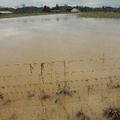根據美國國家海洋漁業局(National Marine Fisheries Service)科學家20日所公佈的官方調查,國家洪水保險計畫(National Flood Insurance Program)違反了瀕危物種法案的規定,為華盛頓州普吉灣(Puget Sound)的虎鯨與數種鮭魚帶來滅絕威脅。
國家洪水保險計畫是由聯邦急難管理局(FEMA)設立。普吉灣周圍城市與郡縣若不遵從漁業局的要求進行調整,就會失去加入聯邦洪險的資格。華盛頓州目前共有252個行政轄區參與洪險計畫,包括39個郡縣,超過200個城鎮,以及兩個部落保留區。
漁業局是受2004年聯邦法院裁決委託,公布這份名為「生態觀點」的調查。西雅圖聯邦法院的奇利(Zilly)法官發現,FEMA洪險計畫鼓勵開發氾濫平原(floodplains),在瀕危物種法案中列為受威脅的鮭魚因此遭到危害。
法官判決FEMA向海洋漁業局進行諮詢,以確保遵守瀕危物種法案,29日發公佈的報告正是諮詢的結果。
 「生態觀點報告」記載了氾濫平原區內,FEMA洪險計畫鼓勵開發的行為。由於多數私人保險業者不願承保氾濫平原內的建築,這些原本無法興建的開發案,由於FEMA保險計畫而得以進行。此外,在FEMA現有的氾濫平原建設最低開發標準中,並未納入環境評估準則。
「生態觀點報告」記載了氾濫平原區內,FEMA洪險計畫鼓勵開發的行為。由於多數私人保險業者不願承保氾濫平原內的建築,這些原本無法興建的開發案,由於FEMA保險計畫而得以進行。此外,在FEMA現有的氾濫平原建設最低開發標準中,並未納入環境評估準則。
報告指出「即使在洪災風險明確之處(例如路易斯郡的闕哈理斯河(Chehalis River), 國家洪水保險計畫目前也未針對氾濫平原開發特別設限,或鼓勵保育氾濫平原有益的自然價值。」
生態觀點報告也提到,「在氾濫平原內進行開發,造成了河川渠道化,棲地不穩定、植被遭到移除、與各種點源與非點源的污染,以上均會造成鮭魚棲地惡化。」
國家海洋漁業局認為,因為洪險計畫承保氾濫平原區的開發,普吉灣的國王鮭(chinook salmon)、鋼頭鱒(steelhead)與互德峽灣(Hood Canal)夏季洄游的狗鮭(chum salmon)都受到危害,造成這些魚類的指定重要棲地惡化,更違反了瀕危物種法案。
 調查也發現,因為獵物數量下降,「南方居民虎鯨」(Southern Resident orcas,俗稱殺人鯨)也而遭受危害。生態觀點報告提出警告,FEMA在普吉灣設立的計畫,可能在未來數年造成當地國王鮭減少30%,而國王鮭是虎鯨的重要食物來源。
調查也發現,因為獵物數量下降,「南方居民虎鯨」(Southern Resident orcas,俗稱殺人鯨)也而遭受危害。生態觀點報告提出警告,FEMA在普吉灣設立的計畫,可能在未來數年造成當地國王鮭減少30%,而國王鮭是虎鯨的重要食物來源。
普吉灣擁有的國王鮭族群,一度曾有37個以上,目前僅存22個。留存的國王鮭數目只剩過去的一成,有些甚至低於過去的1%,數據來自「普吉灣協作會」(Puget Sound Partnership),這個組織聯合了公民、政府、部落、科學家與企業,共同保育守護普吉灣。
依照瀕危物種法案的要求,國家海洋漁業局也提供FEMA一項替代方案,不會危及鮭魚及虎鯨的生存。替代案中包括新的規範,針對氾濫平原與濱水緩衝帶(riparian buffer)的開發,必須加以禁止,或要求完全復原對河川的衝擊。
在敏感區域內的一切開發必須被要求採用「低衝擊開發法」。此種開發方式對本地植物提供特定保護,使用滲透性水泥讓雨水滲入土地,減輕人為踩踏,並以集雨花園吸收風暴帶來的降雨逕流。
The National Flood Insurance Program is pushing orcas and several runs of salmon towards extinction, in violation of the Endangered Species Act, according to a regulatory finding issued today by scientists at the National Marine Fisheries Service.
The National Flood Insurance Program is implemented by the Federal Emergency Management Agency, FEMA. Without making the changes called for by the Fisheries Service, cities and counties around the Puget Sound could lose their eligibility for federal flood insurance. A total of 252 Washington jurisdictions currently participate in the flood insurance program, including 39 counties, over 200 cities and towns, and two tribal reservations.
The federal fisheries agency issued the finding, known as a biological opinion, as required by a 2004 federal court decision. Judge Thomas Zilly of the federal district court in Seattle found that FEMA's flood insurance program encouraged floodplain development and harmed salmon already listed as threatened with extinction under the Endangered Species Act.
He ordered FEMA to consult with the Marine Fisheries Service to ensure compliance with the Act, and the document issued today is the result of that consultation.
The biological opinion documents the ways in which FEMA's flood program encourages development within the floodplain area. Because most private insurers refuse to insure floodplain homes, FEMA's insurance program allows development to occur where it otherwise would not. In addition, FEMA's minimum development standards for floodplain construction currently fail to include environmental standards.
"Even where flood risk is well established (for example, in Lewis County on the Chehalis River), the National Flood Insurance Program’s current implementation does not significantly restrict floodplain development or encourage the preservation of floodplain natural and beneficial values," the biological opinion states.
"Development within the floodplain results in stream channelization, habitat instability, vegetation removal, and point and nonpoint source pollution (NMFS 1996) all of which contribute to degraded salmon habitat," according to the biological opinion.
By insuring development in floodplain areas, the National Marine Fisheries Service determined that the program was jeopardizing the survival of Puget Sound chinook, Puget Sound steelhead, and Hood Canal summer-run chum salmon, and adversely modifying their designated critical habitat in violation of the Endangered Species Act.
It also found that by reducing the prey base for Southern Resident orcas, also called killer whales, it jeopardized them as well. The biological opinion warns that implementation of the FEMA program in Puget Sound could result in a 30 percent reduction of chinook salmon in Puget Sound - the orcas' favored food source - in the years ahead.
Puget Sound was once inhabited by at least 37 populations of Chinook salmon, but today only 22 remain. The remaining Chinook salmon are at only 10 percent of their historic numbers, with some down lower than one percent of their historic numbers, according to the Puget Sound Partnership, a coalition of citizens, governments, tribes, scientists and businesses working together to restore and protect the sound.
As required by the Endangered Species Act, the National Marine Fisheries Service set forth an alternative approach for FEMA that would not result in jeopardy to salmon and orcas. The alternative includes new requirements that development within the floodplain and riparian buffer area be either prohibited or that its impacts to the stream be completely mitigated.
Any development in these sensitive areas should be required to use "low impact development." This type of development specifies protection of native vegetation, pervious concretes that allow rain to flow through to the ground, narrow footprints, and rain gardens to absorb stormwater runoff.
全文及圖片詳見:ENS




